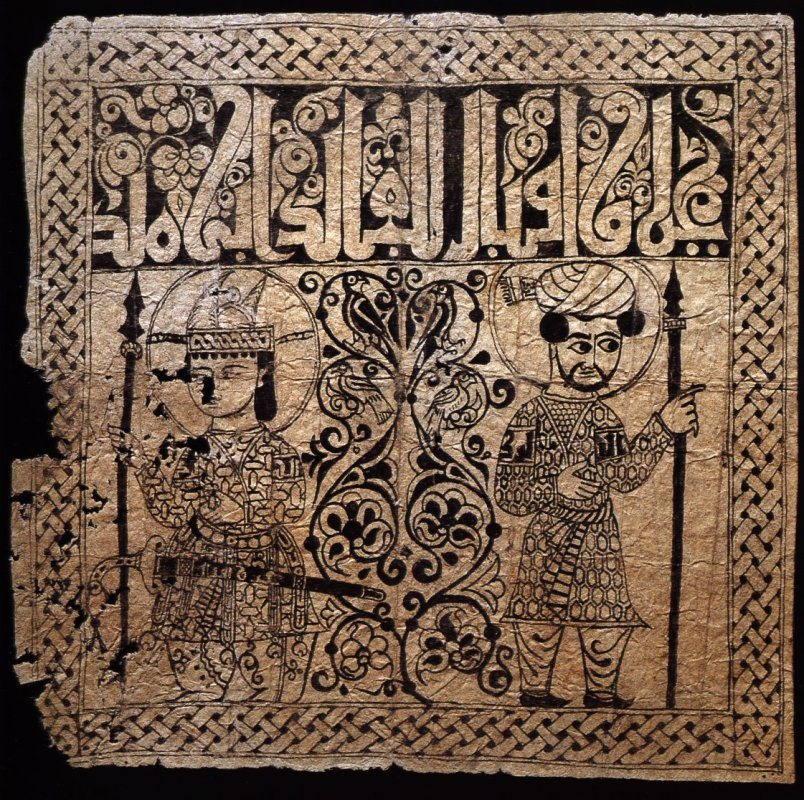
Create an Amazon Wedding Registry
Fatimid Manuscript with two soldiers, 11th - 12th Centuries

A larger image of this Fatimid Manuscript with two soldiers, Fustat, Egypt, 11th - 12th Centuries.
Image source


Drawing of two warriors found in Fustat, Egypt, eleventh century. Ink on paper. Museum of Islamic Art, Cairo. Source.
Referenced on p.32, MAA - 125 The Armies of Islam 7th-11th Centuries by David Nicolle:
One of the clearest painted fragments found in Egypt shows two 11th or early 12th century warriors. The dismounted horseman on the left is a Turk; he wears soft leather boots, and his straight sword hangs from a belt with similar decorative pendants to those seen in the Qasr al Hayr horse-archer fresco. The infantryman on the right, probably a Berber or Arab, seems to wear a mail shirt under his tunic.
Referenced on p.15, MAA - 320 Armies of the Caliphates 862-1098 by David Nicolle:
This painted paper probably symbolised Turkish ghulam cavalry and Berber infantry in the 11th century Fatimid army. (Museum of Islamic Art, Cairo)
Referenced on p.9, WAR - 010 Saracen Faris 1050-1250 AD by David Nicolle and Christa Hook:
Drawing on paper, from Fatimid Egypt, 11th/12th century. On the left a clean-shaven Turk in cavalry boots has a sabre hung from a belt with officer's pendants. On the right a turbaned Arab or Berber with a spear, sash and shoes wears a mail hauberk beneath his tunic.
Referenced on p.100, God's Warriors, Knights Templar, Saracens and the Battle for Jerusalem by Helen Nicholson & David Nicolle:
Drawing on paper, from Fatimid Egypt, 11th/12th century. On the left a clean-shaven Turk in cavalry boots has a sabre hung from a belt with officer's pendants. On the right a turbaned Arab or Berber with a spear, sash and shoes wears a mail hauberk beneath his tunic.
Cairo, Museum of Islamic Art
5 Heavy Black Ink Drawing of Two Warriors Standing Next to an Arabesque-Tree.
Above a panel with large Kufic inscription, the entire representation framed by a quadruple interlace.
Inv. No. 13703
Published:
G. Wiet, Un dessin du XIe siècle, «Bulletin de l'Institute.d'Egypte», 19 (1936-1937), pp. 223-227;
Z. M. Hasan. Kunuz al-Fatimiyyin, Cairo 1356/1937, Pl. 1;
N. Pence Britton, A Study of Some Early Islamic Textiles in the Museum of Fine Arts Boston, Boston 1938, Fig. 99;
Catalogue of the Exhibition of Islamic Art in Egypt, 969-1517, Cairo, April, 1969, p 287, No. 273 and Fig. 49;
A. Marzouk, in Encyclopedia of World Art, V, 1961. col. 364. pl. 252;
M. Rogers. Review of "Exhibition of Islamic Art in Egypt, 969-1517" in «Kunst des Orients», 6-1 (1969) p. 96 expresses suspicion of the object, but is not certain that it is a forgery.
Source: p. 10, A Drawing of Wrestlers in the Cairo Museum of Islamic Art” by Ernst J. Grube in Quaderni di Studi Arabi Vol. 3 (1985)